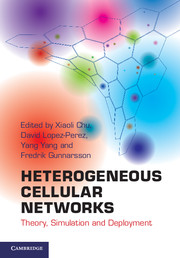Book contents
- Frontmatter
- Contents
- Acknowledgments
- Forewords
- Preface
- List of contributors
- Acronyms
- 1 Introduction
- 2 Radio propagation modeling
- 3 System-level simulation and evaluation models
- 4 Access mechanisms
- 5 Interference modeling and spectrum allocation in two-tier networks
- 6 Self-organization
- 7 Dynamic interference management
- 8 Uncoordinated femtocell deployments
- 9 Mobility and handover management
- 10 Cooperative relaying
- 11 Network MIMO techniques
- 12 Network coding
- 13 Cognitive radio
- 14 Energy-efficient architectures and techniques
- Intex
14 - Energy-efficient architectures and techniques
Published online by Cambridge University Press: 05 June 2013
- Frontmatter
- Contents
- Acknowledgments
- Forewords
- Preface
- List of contributors
- Acronyms
- 1 Introduction
- 2 Radio propagation modeling
- 3 System-level simulation and evaluation models
- 4 Access mechanisms
- 5 Interference modeling and spectrum allocation in two-tier networks
- 6 Self-organization
- 7 Dynamic interference management
- 8 Uncoordinated femtocell deployments
- 9 Mobility and handover management
- 10 Cooperative relaying
- 11 Network MIMO techniques
- 12 Network coding
- 13 Cognitive radio
- 14 Energy-efficient architectures and techniques
- Intex
Summary
Introduction
Digital information exchange is seen as a key enabler in modern economics, and one of its most challenging aspects is the heterogeneous nature of modern wireless networks. Over 1.4 billion user equipments (UEs) are connected to the cellular network with over 3 million base stations (BSs) [1]. The volume of data communicated via information communication technology (ICT) infrastructures has increased by more than tenfold over the past 5 years. According to [2], the global mobile data traffic is expected to reach 6.3 exabytes per month by 2015, which is more than 26 times the mobile data traffic per month in 2010. A recognized target by the United Nations is to improve both the coverage and the capacity of cellular networks, in order to foster economic growth and reduce the wealth and knowledge gap among countries. It is important to achieve the aforementioned level of wireless connectivity, whilst consuming a low amount of energy and incurring a low cost, due to the growing concern over the environmental damage caused by carbon emissions. The greenhouse effect is mainly caused by excessive emissions of carbon dioxide (CO2) in the last century. As reported in [3–5], human industrial activities emit twice as much CO2 as natural processes can absorb at the moment. Globally, ICT infrastructures consume approximately 3% of the world's total energy [5, 6]. In particular, up to 20% of the energy consumption of the ICT industry is attributed to wireless networks [7], the scale of which is still growing explosively [4]. Roughly 70% of the wireless network energy is consumed by the outdoor macrocell BSs.
- Type
- Chapter
- Information
- Heterogeneous Cellular NetworksTheory, Simulation and Deployment, pp. 426 - 452Publisher: Cambridge University PressPrint publication year: 2013



